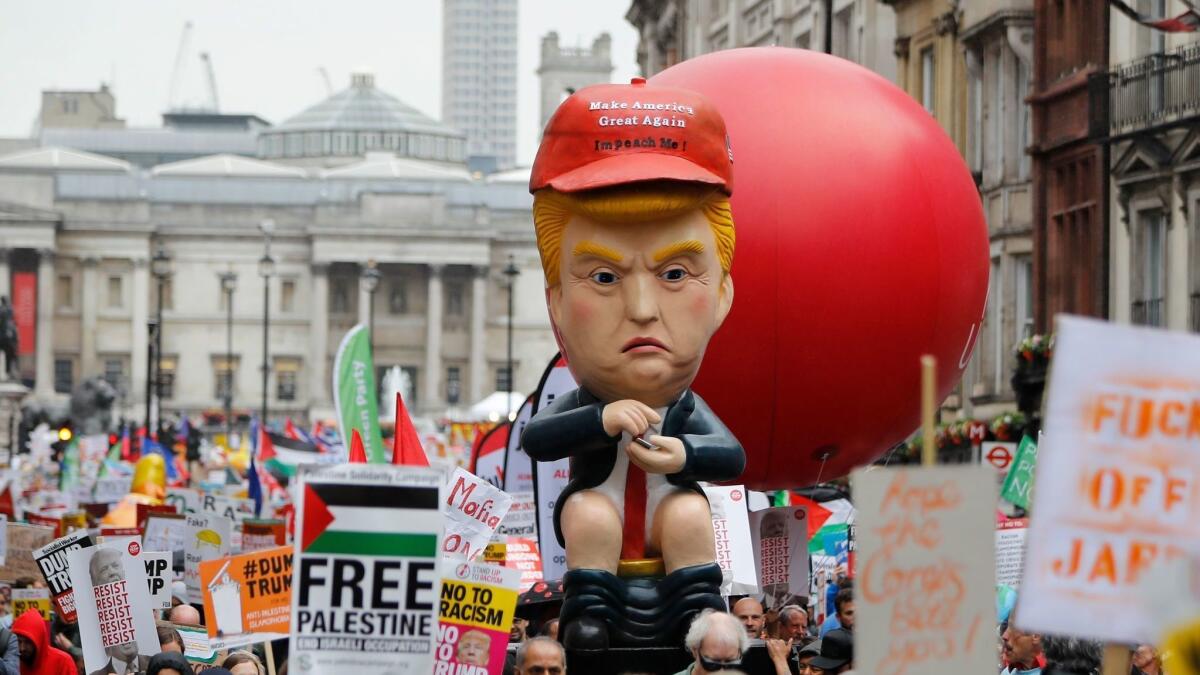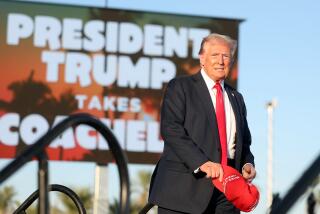Column: Twitter’s response to London’s Trump protests were great fun and just what he wants

The ill-fitting tux, Camilla’s wink, the Resist Trump banners, the First Lady’s hat, the protocol-breaking back-pat, the anti-Trump projection art on landmark buildings, the cacophony of clever signs in Trafalgar Square and, of course, the baby blimp — the president finally went to London to visit the queen and virtually every moment went viral.
What a surprise.
The British do not like Donald Trump. If the deserted welcome route where cheering Obama fans once stood did not make that clear (seriously, if they had tumbleweeds in London, there would have been tumbleweeds), an activist group projected his approval ratings in the U.K. (21%) next to Obama’s (72%) onto the Tower of London.
The Tower of London, man, where approval ratings used to mean something.
Americans could not get enough of a trip that combined at least three of their favorite television obsessions — Trump, the royal family and the sting of British comedy. (Camilla’s wink was pure “Fleabag”; if Phoebe Waller-Bridge had somehow managed to provide on-site narration of the events, the international power grid would have completely shut down.)
For two days, the retweet-with-comment multitude provided running commentary. They complimented the Brits on their shade-throwing ability (just as if the British had not invented shade-throwing), apologized for Trump’s presence/presidency/inability to look good in a picture and generally had a high old time watching the people who invented colonization and reality television tear into the racism/sexism/narcissism of Donald Trump.
(My personal favorite may have been the many-times-retweeted video clip of Guardian columnist Owen Jones who, while explaining that the Brits need not show respect for a man who shows so little respect for others, angrily interrupts the woman beside him when she quietly attempts to correct one of his points.)
It was all so predictable. And totally counter-productive.
Not the protests, which are legitimate political discourse, or the news coverage — the fact that most of those who came out for the president’s visit were protesters is absolutely news, and that tux, well, the president does have a rather unique fashion sense.
But all the social media high-fiving and meme-generation and media-moment making? If the purpose is to convey dissatisfaction with Trump’s presidency, this is not the way to go about it. Trump and his supporters live for this kind of thing.
Anyone who thinks Trump is lying when he says enormous crowds greeted him upon arrival has not been paying attention — the fact that those enormous crowds were made up of protesters doesn’t matter. They were people who came out to see him. And those signs they were carrying? Just part of the show, proof that he is fulfilling his campaign promise to not care what anyone who is not a “real” American thinks.
Tweet what you like; if you’re having fun, he’s having fun. Just don’t fool yourself into thinking #Trumpinsaninterationaldisgrace is going to shame him or change anything. At this point, social media is simply Trump’s studio audience, cued to react whenever he does or says just about anything.
Twitter is the president’s medium of choice, a place where he can vent and splutter and address his base without having to answer any pesky follow-up questions. The more combative the mood, the better he likes it.
He had primed the pump for his London visit with an incendiary tweet, in this case directed at London Mayor Sadiq Khan who, according to Trump, “has done a terrible job as Mayor of London, has been foolishly ‘nasty’ to the visiting President of the United States, by far the most important ally of the United Kingdom. He is a stone cold loser…”
He followed that up by criticizing the “fake news” of CNN and calling on AT&T to “do something” about it.
Frankly, it was not his best work; at this point insulting fellow politicians feels canned, the criticism of media outlets prewritten, possibly put on a timer; only when CNN doesn’t get slammed should AT&T start to worry. But the statements were duly reported with whatever passes for outrage when outrage is the default setting and subsequent commentary moved through the Twitterverse with all the verve of those poor dancers at the end of “They Shoot Horses, Don’t They?”
Khan, knowing an opportunity when he’s been gifted one, quickly released a video informing Trump that he stands for “the opposite of London’s values,” and calling him out for rolling back progress, particularly in gender equality, which was a bit telling. The focus on women only emphasized the fact that even Khan can’t lean into Trump’s calling card — immigration — because, you know, Brexit.
It was precisely the fight Trump wanted, and we know he wanted it because he started it. He won the presidency with combative rhetoric, and combative rhetoric is precisely what he hopes will keep him there, particularly when that war of words occurs almost exclusively in a space where no one who questions or disagrees with him is physically present.
We all understand the dangers of social media, just as we know its benefits. It is modern graffiti — full of art, social messaging and a whole lot of messy blight. It is a communal platform that can be highly democratic and, as the Mueller report proved, easily manipulated, a place of connection that can reveal larger truths and spread enormous lies. On it, we raise consciousness and create mobs in equal proportion.
In other words, chaos. And, to quote another source of recent social media frenzy, for those not bound by conventional definitions of honor, “Chaos is a ladder.”
The president goes to London, much of the local citizenry protests, and social media goes wild in a way that is, it must be admitted, a lot of fun to witness.
Lost in all the excitement is, once again, the line between politics and entertainment, now trampled underfoot by those protesting a man who became president because he understands that line exists only if we believe it does.
The mainstream media took a lot of heat for covering the Trump campaign as if it were a circus rather than an actual, and eventually successful, attempt to make him president. Yet even after revelations that Russian operatives were able to use social media to spread disinformation with the express goal of influencing our presidential election, we continue to use those platforms for political discourse.
The best thing about the London protests were the fact that they were protests; people took time on weekdays, spent money, made signs, found parking, built effigies, and, in one remarkable case, mowed a message into the grass. Not just in London; all over the country.
Americans with similar feelings, meanwhile, seemed content to hit retweet.
Social media campaigns may be an effective way to protest many things but not the Trump administration. The first rule of battle is to choose a place where your opponent is at a disadvantage, and when facing off against Trump, Twitter ain’t it.
More to Read
The biggest entertainment stories
Get our big stories about Hollywood, film, television, music, arts, culture and more right in your inbox as soon as they publish.
You may occasionally receive promotional content from the Los Angeles Times.











